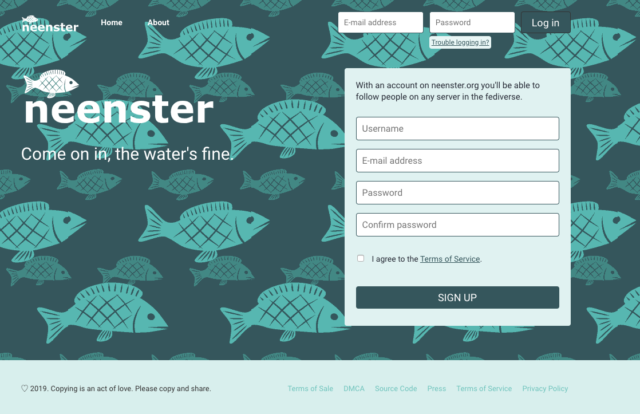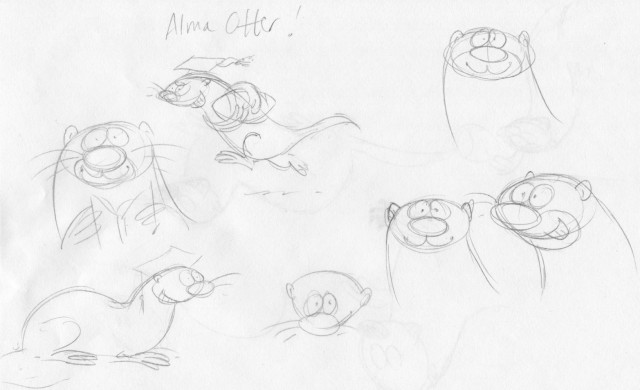Category: Free Culture
Introducing Neenster
A new social media platform/fediverse instance!

Q. What is Neenster?
A. Neenster is an open-source social media platform aimed at my existing social media friends and followers, and their friends and followers, and so on. My hope is that an account here will offer a soft landing into the “fediverse”, a giant network of network instances like this one. Well, technically like this one, but in terms of personality and audience, very different; fediverse instances range from highly policed insular bubbles, to completely unmoderated ideological hazmat zones. Neenster is somewhere in between. Once you have a Neenster account, you can discover other fediverse instances, and even start your own.
Q. Do you moderate this thing?
A. I plan to moderate Neenster like I “moderate” my fecebook wall: mostly by doing nothing, but occasionally blocking particularly abusive and annoying people according to how much they piss me off. Ideally users will moderate themselves by using their god-given blocking fingers. Remember: MUTE and/or BLOCK. It’s like brushing your teeth, but for your sanity.
Q. Does Neenster cost anything?
A. Accounts are free, and there’s no advertising or data collection, or profit. I pay for hosting and the domain. It’s my experiment, and my responsibility. If you want to contribute to my expenses, you can donate via the left-hand sidebar.
Q. Why is it called Neenster?
A. It’s named after me, Nina Paley. The -ster suffix is because it’s based on Spinster, where I’ve been a moderator almost since its founding. Neenster is spelled phonetically because people wouldn’t pronounce Ninster correctly. The name makes it clear that this instance is my experiment and my responsibility. I’m not trying to do anything more than host a bunch of my online friends, acquaintances, and frenemies away from fecebook. A cooler name would imply greater ambitions and impartiality, which I don’t have.
Q. Is Neenster trans-inclusive?
A. Yes. Trans people are welcome here.
Q. What about women?
A. Yes, women are welcome here.
Q. And men?
A. Yes, men are welcome here.
Q. You said I was welcome but someone here hurt my feelings!!
A. People will hurt your feelings online (and elsewhere). You can ignore them, mute them, or use your god-given blocking finger to block them.
Q. YOU’RE A HATEFUL BIGOT!!
A. This is the sort of thing that’s not welcome on neenster.org
Q. Do I have to use my real name?
A. No, but I’d like it if you did.
Q. What is your biggest concern about social media?
A. Mobbing/dogpiling. Few individuals who make up online mobs break any rules, but as groups they wreak havoc. The loveliest, nicest people join mobs. I’m extremely curious to learn if anything can be done about mobbing, because thus far I’ve seen it on every conceivable online platform, even with the best possible participants and intentions.
Q. Why the fish?
A. Because they look cool.
Q. I notice a lot of animated gifs here
A. Aren’t they cool? I’m an animator, I love them.
Q. How do I turn off the damn gifs?
A. Under “Preferences”, uncheck “Auto-play animated GIFs”.
more at https://neenster.org/about
The Alma Otter
The University of Illinois hasn’t had an official mascot since 2007, when they retired “Chief Illiniwek.” Like many people I despised that mascot and consider it racist. However, I despise attacks on Free Speech even more. The University is in a bind right now, because when they eliminated the “Chief,” they failed to replace it with a new mascot. Consequently many U of I sportsball fans and alumni continue to “support the Chief” while the U of I misuses trademark law in weak attempts to stop them, mostly for virtue-signal points. This article in the local rag today got me thinking (text below, until I receive a copyright threat):
Pro-Chief group plans event for Saturday’s game
|CHAMPAIGN — As the University of Illinois weighs how best to move beyond Chief Illiniwek, a pro-Chief group has organized another “Paint the Hall Chief!” event for Saturday’s Illini game at State Farm Center.
Students for Chief Illiniwek, a registered student organization at the UI, posted a notice online calling on fans to “Honor the spirit of Chief Illiniwek” by wearing Chief gear to the 11 a.m. basketball game against Penn State.
The group calls itself a “progressive Registered Student Organization that supports the education of students and the surrounding community on the subject of Chief Illiniwek and related symbolism, and the right to their free expression of support.”
Last year, the student group hosted a similar event on Senior Night, the final home game of the season.
It caused tensions beforehand, with Chief opponents demanding that the UI or government officials stop the event and the university forcing the student group to stop using officially trademarked Chief images or similar logos to advertise it.
Opponents had argued that the event violated university rules, state and federal anti-discrimination laws and the UI’s agreement with the NCAA to stop using American Indian symbols in its athletic program.
UI officials called it a free speech issue and said they can’t control whether fans wear the Chief logo on their shirts.
In the end, the event prompted a few extra Chief shirts in the crowd and 40 protesters outside, but no appearance by a Chief portrayer.
“They certainly have the right of free expression and free speech,” campus spokeswoman Robin Kaler said Friday. “They also have to exercise those rights in a way that complies with our policy and the rules of the facility.”
Chief opponents have argued that events such as “Paint the Hall Chief” or appearances inside the arena by unofficial Chief portrayers constitute a protest of the UI’s decision to retire the Chief and therefore should also be banned.
State Farm Center rules ban any protests inside the center and limit them to designated outdoor areas that don’t block any exits or entrances to the arena. Flyers can be distributed outdoors as long as the message is not commercial or political, according to the policy.
Last year, the student group Turning Point USA also distributed “Honor the Chief” flyers inside the area, and about 200 were confiscated by State Farm Center staff.
UI student Blair Nelson, a member of Turning Point and Students for Chief Illiniwek, did not respond to questions about whether a Chief portrayer might appear or whether organizers planned to hand out fliers again this year.
“Planned for the day will be a showing of true Illini spirit from the most dedicated supporters of the university. We encourage fans to pick up their Chief gear this week from any number of local retailers and wear that gear proudly to the game to show their support! Our focus is in the whole community’s participation, not individual attendance,” he wrote in an email.
Kaler noted that the event comes as the Commission on Native Imagery appointed by Chancellor Robert Jones is trying to “find a path that recognizes our shared history but also helps develop new traditions that bring our community together.”
“We definitely think that tradition does not bring people together,” she said, noting that Native American students and faculty have made clear that the Chief is hurtful.
Illinois Student Government President Walter Lindwall said Monday he wasn’t sure whether any student groups planned to protest the event.
The UI retired the Chief in 2007 under pressure from the NCAA after more than a decade of protest from groups who considered it a racist mascot, and it stopped mass-producing Chief merchandise soon afterward. But it retained ownership of the Chief trademark to maintain control of its use and has challenged pro-Chief groups’ use of it in the past.
Students for Chief Illiniwek had used a circular logo to advertise the 2018 event that was based on the official Chief logo, with State Farm Center’s seating chart replacing the feathers in the Chief’s headdress. The UI complained that it was too similar to the trademarked Chief logo still owned by the university. The revised announcement used a photo of State Farm Center instead.
Organizers also altered the title of the event slightly, replacing the “e” in “Chief” with a logo developed in 2012 by the Council of Chiefs (past Chief portrayers) — three orange and blue horizontal stripes forming a profile.
And the UI told the student group to stop using a photo of the last official Chief Illiniwek portrayer, Dan Maloney, at a UI basketball game, saying the university owns the copyright to that image.
This year’s event notice features a photo of an unofficial Chief portrayer standing in the crowd during an Illini basketball game.
Free Speech includes speech one finds abhorrent, so I don’t want to see “Chief” supporters suppressed. A better solution would be the adoption of a new mascot, which the University has failed to do for over a decade. But recently a viable alternative was posted to Reddit: The Alma Otter (a play on the Alma Mater). There are now a few fecebook pages promoting the Otter, but so far only illustrated with photographs.
This is where a cartoonist is needed.
I banged these out this morning. Surely Alma Otter can be refined and altered, but does s/he have promise? If the “Chief” fans are making their own t-shirts and sweatshirts and buttons and stickers with no endorsement from the University, why should Alma Otter fans wait for official adoption? Start merching now. Alma Otter is cuter, friendlier, and less disgusting than the “Chief,” with lots of imprint possibilities. Since I’m a Free Culture advocate, and since the University has no trademark on Alma Otter, I invite one and all to MERCH THE HELL OUT OF IT. No permission needed- these are all Free Culture, go for it. If you have a merch plan and the money to produce it, I will gladly draw more Alma Otterage for it.
Please, please, show how it’s possible to both eschew racism and support Free Speech.
Update March 1 2019: In today’s local letters to the editor!
Seder-Masochism now Free online!
Essay: Religion is Like a Fungus
Some of the most maladaptive social behaviors I see seem to indicate deep human longings for religion and/or magic. Here’s something I wrote about religion in December. It’s weird. You don’t have to agree.

Religion is like a fungus: seemingly toxic, but an essential part of an ecosystem we don’t understand.
Culture is alive. Just as physical living organisms are interconnected in complex ways, so are cultural organisms.
Our usual approach to Life is to think of organisms as discrete individuals. The plant is one thing, the soil is another, the insects another, and the fungus is some pathogen or pest. The animal is an individual, whose life processes are carried out by its individual organs. A human is one thing, culture is another; an intestine is one thing, gut flora are another.
Only recently have we acknowledged that animal digestion relies on bacteria. Without internal bacteria, animals cannot live. That bacteria is communicated through a complex living environment we remain mostly stupid about.
Religion is like a fungus. Consider Penicillium: a mold that spoils bread. No one wants moldy bread. If our bread is moldy, we curse the mold, and perhaps dream of a world in which mold is eliminated.
Suppose we succeed in wiping out the nasty bread mold. Do we end up with clean, pure bread? No, we open the door to far more toxic organisms.
I am highly critical of established religions. Terrible things are done in their names. They do seem toxic.
But a human mind without religion does not become some pure, rational ideal. The human mind never was and never will be pure or discrete. The human mind exists in a cultural ecosystem we do not fully (or even begin to) understand.
Because cultural ecosystems are barely acknowledged, let alone studied, there aren’t well-developed ways to talk about them. I use the metaphor of soil: human minds are the soil in which culture lives. Culture itself may be “airborne,” like spores. A human mind with permeable ears and eyes will be colonized by music, images, language, gestures, sounds, patterns, and much more we can’t even name. Trying to stop culture from entering a mind by enclosing it just makes the system unhealthy – like wrapping food in plastic. It works for a short time, but eventually traps colonies of microbes, and not the ones you want.
Better to keep the mind nicely aired out, with an open flow of culture around it, so it can stay healthy.
Established religions may protect minds against even more toxic cultural organisms, just as Penicillium makes bread inhospitable for pathological bacteria. For all its faults, Abrahamism may protect minds from even worse ideologies.
Atheism has become very popular in the West over the last few decades. I’m all for it. Except…it has coincided with the rise of some pretty toxic new religions. Foremost is genderism, the belief in an unprovable, indefinable gendered essence (soul) that can be born in the wrong body. Genderism is remarkably popular among professed atheists. Danielle Muscato is a prime example.
This is anecdotal, and I am only one data point, BUT: I’ve noticed that the most toxic, extreme genderists tend to identify as atheists, while many of the most benign and rational genderists I’ve encountered practice a traditional religion (Christianity). They may not even be genderists per se, but they are transsexuals. I speculate their established religion protects them from the worst cultural toxins – misogny, dishonesty, entitlement, violence – attendant to gender extremism.
For all my criticism of religion, I conclude that humans may need it. Killing off religion may be like killing off “pests”: seemingly beneficial in the short term, but having complex effects on the larger ecosystem that can be catastrophic. Healthy soil needs – largely is – fungi and bacteria. Healthy minds – the soil of culture – may require similarly unsympathetic cultural organisms. Like physical Life on Earth, most mental life is “below ground,” and staggeringly complex. The writhing colonies of organisms that live in dark places may disgust us, but our life and health depend on them.
PRESS RELEASE: Seder-Masochism to go Public Domain January 31, 2019
—PRESS RELEASE—
On Thursday, January 31, Nina Paley will dedicate her new feature film Seder-Masochism to the public domain, releasing master files on archive.org.
Seder-Masochism, an animated musical, loosely follows the Passover Seder story, with events from the Book of Exodus retold by Moses, Aharon, the Angel of Death, Jesus and the director’s father. The film puts a twist on the traditional Biblical story by including a female deity perspective – the Goddess in a tragic struggle against the forces of patriarchy.
Seder-Masochism has been in the works since 2012 when Paley first animated a scene called This Land Is Mine, a parody about never-ending conflict in the Levant which has been viewed over 10 million times on various online channels.
In addition, Paley has written and designed a companion book, The Seder-Masochism: A Haggadah and Anti-Haggadah, currently available through Amazon.
Paley released her first feature, Sita Sings the Blues, for free to the public in March 2009 under a Creative Commons Share-Alike license, dedicating it to the public domain 5 years later. Contradicting movie industry expectations, the more people saw Sita online, the more they sought it out in theaters and film festivals. In December 2009, Sita enjoyed a 5-week run at the IFC Film Center in New York (extended by popular demand beyond its planned 1-week run), and it continues screening in theaters, festivals, and special events to this day.
Accustomed to working outside the mainstream movie industry, Paley has made Seder-Masochism a one-woman project: she wrote, directed, and animated it herself on a total budget of $20,000. Being independent allows her to release and distribute her films in unorthodox ways – such as into the public domain.
A Public Domain dedication (using a Creative Commons license called CC-0) means anyone can re-use, remix, and redistribute the work, with no restrictions. All of Paley’s animation and images will be free for anyone to use however they wish; however the music will continue to be controlled by its copyright holders.
Paley has no plans to pursue commercial distribution for Seder-Masochism. “I claim Fair Use for the music, but distributors are loath to do that. Instead they’d want to obtain music licenses, which would be daunting,” she says.
Seder-Masochism has screened at nearly 20 festivals thus far, including the Vancouver International Film Festival, the Annecy International Animation Festival, and the Jewish International Film Festival of Australia. It is scheduled for more festivals through Spring 2019, including the New York Jewish Film Festival in January.
The Digital Cinema Package (DCP) release will be issued later in 2019, so that upcoming film festivals can be assured of regional theatrical premieres.
The release of her films into the public domain is just the latest effort Paley has undertaken to advocate for Free Culture. In 2008, while navigating copyright for Sita Sings the Blues, she joined the nonprofit QuestionCopyright.org as artist-in-residence, where she later created a series of shorts about Free Culture called Minute Memes. She has spoken extensively about copy restrictions and art, including her 2015 TEDx talk “Copyright is Brain Damage“.
For more information, visit sedermasochism.com or email nina@sedermasochism.com.











